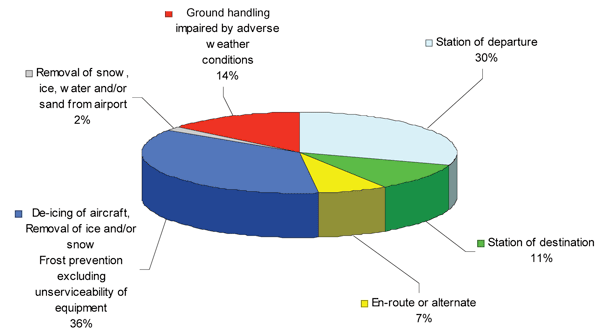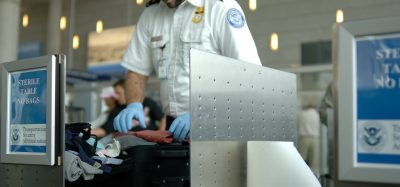Airports and aviation weather services: A new alliance forming?
- Like
- Digg
- Del
- Tumblr
- VKontakte
- Buffer
- Love This
- Odnoklassniki
- Meneame
- Blogger
- Amazon
- Yahoo Mail
- Gmail
- AOL
- Newsvine
- HackerNews
- Evernote
- MySpace
- Mail.ru
- Viadeo
- Line
- Comments
- Yummly
- SMS
- Viber
- Telegram
- Subscribe
- Skype
- Facebook Messenger
- Kakao
- LiveJournal
- Yammer
- Edgar
- Fintel
- Mix
- Instapaper
- Copy Link
Posted: 1 December 2006 | Dr. H. Puempel, Chief of Aeronautical Meteorology Unit, World Meteorological Organization (WMO) | No comments yet
Ever since the Wright Brothers, prior to the first motorised flight, worried about prevalent wind directions in 1904, aviation and weather have been twinned by fate and forced to work together. Aviators learned to respect weather from the day that they first attempted to fly; apart from human error, it still plays the biggest role when things go wrong.
Ever since the Wright Brothers, prior to the first motorised flight, worried about prevalent wind directions in 1904, aviation and weather have been twinned by fate and forced to work together. Aviators learned to respect weather from the day that they first attempted to fly; apart from human error, it still plays the biggest role when things go wrong. When the great travelling public decides on the most appropriate form of transport to reach its intended destination, price is one consideration, but not the only one. Creature comfort, reliability in schedules, safety and absence of hassle play an increasingly dominant role when price wars in the entire transport world have led to a situation where cost has almost been marginalised for popular destinations.
That is where we need to open up our view from the simplistic consideration of what the flying time is between A and B. Flying time, at least on short-haul continental travel, is fast becoming the shortest part of the overall journey time, and possibly even the most comfortable. It is reaching the airport, disposing of the vehicle that took you there or lugging your haul out of trains, undergrounds or buses that is the trouble spot. Let’s not discuss checking in with all the questions on who packed this tube of shampoo without your knowledge? And once we’ve made it to the gate, it’s the big question: What reason will be given for today’s delay? That is when weather comes in handy as an excuse for all the potential perpetrators. So let’s look on how weather influences all activities in aviation, what is being done to analyse and predict it, and how this can help to mitigate the negative effects on all stakeholders.
What regulatory framework is in place to ensure that weather information is current, accurate and delivered to the people who need it?
Aviation is probably the most international business apart from banking, and thus there are several international organisations that have been entrusted with the regulation of services to aviation. The International Civil Aviation Organization (ICAO) is treating all aspects of the regulations on safety and regularity of aviation operations, and it defines the requirements to which all service providers, be it air navigation services, weather services or communications, have to conform. WMO, the world’s authoritative voice on weather, water and climate is taking care, by its Aeronautical Meteorology Programme, to implement and regulate the provision of aeronautical meteorology services to all stakeholders of aviation. These two sister organisations, both part of the family of UN organisations, closely cooperate in their quest to keep flying safe, efficient and on time. While the provision of aviation weather services to air crews and operators is regulated in great detail and closely monitored by national and international authorities, the provision of services to airports is, to some extent, left to individual service agreements concluded between airport authorities and weather service providers, with the format, contents and conditions of service provision mostly open to very individually negotiated arrangements. Separate arrangements with surface transport companies, airlines, environmental watchdogs, the general public and the media exist in a fairly uncoordinated fashion, and one could consider it high time that a more coordinated approach is considered by all parties. Remember, it is the overall travelling time, comfort and reliability that will influence the travellers’ choice of which form of transport to use next time. So, without advocating any interference from the State or international bodies, it can be demonstrated that a need for coordination exists if the future of air transport is to be developed in an organised way.
What about the safety on ground?
As we said before, ICAO and WMO are regulating with great diligence all aspects of safety for air crew and passengers while in the aircraft. But, the risks to crew, passengers and ground handling staff do not stop when the engines have been turned off. Let’s look at some of the weather hazards that affect people on the ground: • Thunderstorms: Lightning strike has been the cause of many injuries and even deaths among ground handling staff at airports. It poses a considerable risk to refuelling and baggage handling operations. Aeronautical weather service providers are increasingly being asked to provide highly accurate and reliable forecasts of the risk of lightning strikes, and many airports have developed policies to shut down ground handling when lightning strikes are coming too close for comfort (typically about 3 miles from the airport).
- Wind storms: During the passage of violent gust front at a European regional airport in 2004, two large baggage containers (of a medium sized jet aircraft) were lifted up and flew for a distance of about 200m, to be found resting in a field way outside the perimeter fence.
- Ice and snow: Passengers on the way to the aircraft stairs are in danger of serious injury in case of black ice that is not removed in time, with law suits costing airport authorities large sums of money.
All these hazards require reliable, timely and accurate warnings to the relevant airport departments so that remedial action, precautions and mitigating measures can be taken in time. Insurance companies increasingly insist on weather information when being asked to cover for incidents of that kind, and any proper procedure in place assuring the timely information flow to the decision makers in charge, will help to avoid costly legal action at a later stage.
What about the economics of weather information?
Weather information does not come for free and it is important for CEO’s of all aviation stakeholders to understand that cutting costs is more than eliminating the bills of service suppliers. The cost-benefit ratio of weather information, although very difficult to nail down to the last digit, has been shown on many occasions to be close to 1:100 for many aviation-related operations. Where does that claim come from?
- Studies in the US have shown that the cost of weather-related delays to the aviation sector could be as high a several billion US$ per annum. It is extremely difficult to give a precise figure for the percentage of this cost that can be avoided using accurate weather information several hours ahead of an event, but conservative estimates arrive at 10-20 per cent, which is a large multiple of the cost of aviation weather services.
- European studies for individual airports have also shown that weather related delays figure very prominently in the aircraft departure delays. C. Peer (2003) has given an example for Vienna airport in an M.SC thesis in figure 1 for the winter of 2002:
The cost of snow and ice removal from airports is staggeringly high in many mid-latitude airports, and to maintain the technical and staff resources to be able to cope with a major snow fall event can be significantly reduced if an accurate forecast of the timing and intensity of the event is available. Freezing rain, the horror scenario of many aviation activities, is extremely difficult to cope with unless protective action has been taken before the onset of the event. The limited number of aircraft de-icing stations available, the time needed to preheat the liquid and the personnel required to perform the necessary de-icing all combine to define the requirements for early warning of the rare, but costly incidents of such freezing precipitation. Again, we need to consider aviation as a joint venture exercise, and individual cost-benefit-considerations by isolated stakeholders are likely to lead to severe degradation of the overall system performance if the effects of one’s decision on the remaining stakeholders are neglected. If, for example, the contractor in charge of clearing the parking lot is scrutinising only his expenditure for equipment and personnel, he may be tempted to risk failing his obligation in a few cases of extreme weather, not realising that his failure may, in effect, upset the entire value generating chain at this airport. When it comes to more central services, failure of one component will quickly spread to an entire region if aircraft start to divert, other airports exceed their acceptance capacity as a consequence and thousands of travellers are affected, disgruntled and tempted to go surface next time they travel.
What if all hell breaks loose?
The real test for airports comes in the case of a real emergency and weather again features prominently among the possible causes. Tropical cyclones, snow storms, floods, dust and sand storms all have the potential to cause havoc for the air transport industry, and this is when a well-coordinated service delivery has been in operation, tried and tested between airport authorities, airlines and weather service providers. The images of New Orleans under hurricane Katrina, the situation at the large US and Canadian airports after the big ice storms and images of airfields disappearing under sand drifts are vivid reminders of the power of nature. These situations can only be handled with a degree of success if several conditions are met:
- Early warning systems are in place and communications channels are well established.
- Emergency response plans and teams are in place, trained and capable to withstand the unavoidable stress and chaos in a high-tech environment often deprived of basic services such as water or power.
- Communication to all stakeholders via dedicated channels is assured and tested.
- The media can be handled professionally so that they help to reduce, not increase the chaos.
Several examples of excellent coordination have been seen in the recent past and they should serve to others as a role model before the next emergency arrives. Climate change, the rise of sea levels and the increased frequency of severe weather events emerging as a consequence of this global change must be taken as a wake-up call to senior management in all partner organisations of aviation. The meteorological community and its aeronautical service arm are standing by to help and advise in these difficult times, but as a Swedish experienced forecaster once said, “The best forecast has no value unless it is being used!”
Aviation and the environment – an increasingly stormy affair?
Times are getting harder for all industries seen to contribute to the greenhouse gas inventories responsible for global climate change, to the aerosols that make up the modern whiff of urbanisation, and to the noise levels that keep some of us from sleep or rest. It has become normal to look at aviation as one of the main factors in some of these fields, if not for absolute values (aviation still only contributes about 2 per cent of all Carbon Dioxide that is blown into the atmosphere), but for its growth rates that economists would call very healthy but doctors and environmentalist certainly would not. What can aviation meteorology do to rationalise the debate? There are some very hopeful signs that the close cooperation between aviation and meteorology may be able to help mitigate some of the unwanted side-effects of this otherwise beneficial activity:
- Precise forecasts of atmospheric conditions in the boundary layer will help to determine when critical thresholds of local air quality may soon be reached, and overall emissions inventories need to be considered (there is no point singling out aviation in a sea of polluters in these circumstances and community leaders may have to make difficult decisions as to what is more important – to allow vehicular traffic to enter the cities, to generate power from coal fired stations, or to stop aviation when the going gets tough.)
- It may soon be possible to determine very precisely those layers in the atmosphere that are prone to condensation trails and cirrus formation, so that these could be avoided – in particular during the night hours, where their effect is largest and air traffic is least dense.
- Improved flight planning based on highly accurate forecasts can help to reduce unnecessary holdings, deviations and ground queues at major airports.
So, even in the field of environmental protection, meteorology can be a partner of aviation, helping to reduce and mitigate its impact on the environment. Talk to your national or local weather service, discuss your requirements, and negotiate a deal – it will be to your benefit!


Figure 1
Dr. Herbert Puempel
Dr. Herbert Puempel was appointed Chief of the Aeronautical Meteorology Unit at the World Meteorological Organization (WMO) in April 2005. He first became involved with the Organization’s Commission for Aeronautical Meteorology in 1991, when Head of the Innsbruck Airport weather office of Austrocontrol, and later became Chair of its “New frontiers” Working Group TREND, a member of its Management Group.
















